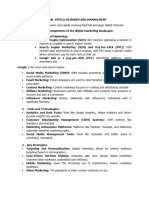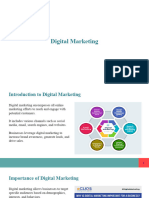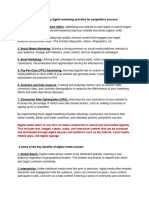0% found this document useful (0 votes)
9 views6 pagesLecture Notes - Lecture 1 To 8
The document provides an overview of marketing, emphasizing its importance in creating value for customers through elements like market research, product development, branding, and advertising. It introduces Integrated Marketing Communication (IMC) as a strategy for consistent messaging across channels, and discusses digital marketing fundamentals, including various channels and campaign planning. Additionally, it covers the customer journey, persona building, and the significance of touchpoints in enhancing customer experience.
Uploaded by
ashumiikkiiiCopyright
© © All Rights Reserved
We take content rights seriously. If you suspect this is your content, claim it here.
Available Formats
Download as PDF, TXT or read online on Scribd
0% found this document useful (0 votes)
9 views6 pagesLecture Notes - Lecture 1 To 8
The document provides an overview of marketing, emphasizing its importance in creating value for customers through elements like market research, product development, branding, and advertising. It introduces Integrated Marketing Communication (IMC) as a strategy for consistent messaging across channels, and discusses digital marketing fundamentals, including various channels and campaign planning. Additionally, it covers the customer journey, persona building, and the significance of touchpoints in enhancing customer experience.
Uploaded by
ashumiikkiiiCopyright
© © All Rights Reserved
We take content rights seriously. If you suspect this is your content, claim it here.
Available Formats
Download as PDF, TXT or read online on Scribd
/ 6






















































































